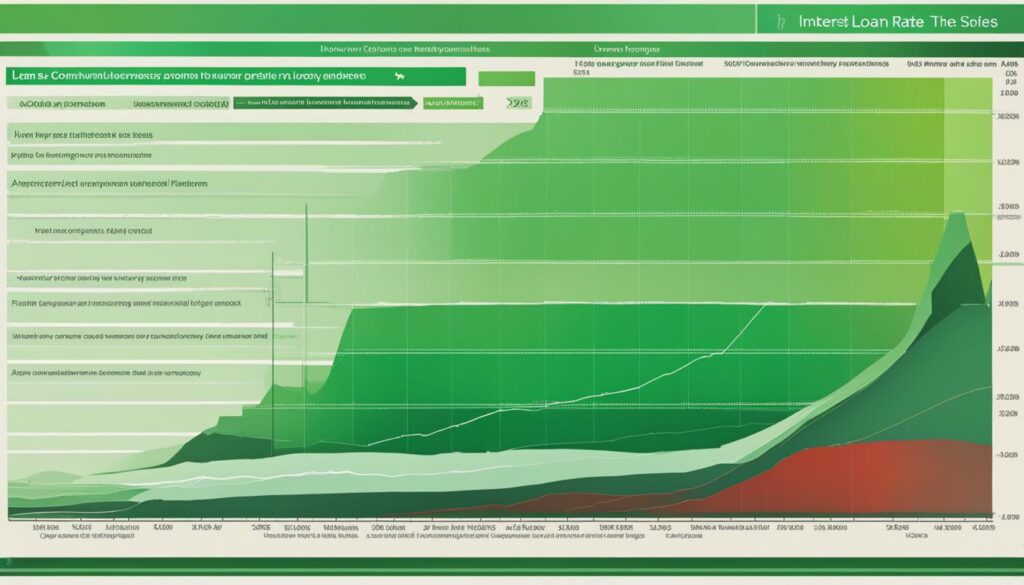Are you struggling to break free from the burden of student loan debt? You’re not alone. Many families find themselves trapped in a vicious cycle of mounting debt, struggling to make ends meet and unable to envision a debt-free future.
The rising costs of tuition coupled with the ever-increasing interest rates have left countless individuals drowning in student loan debt. The weight of this financial burden can feel overwhelming, but there is hope. By understanding your student loan options, you can take the necessary steps towards escaping the debt trap and achieving financial freedom.
Key Takeaways:
- Many families are trapped in a cycle of paying the minimum on credit cards and struggling to make a dent in principal.
- One-fifth of U.S. homeowners are currently underwater on their mortgage.
- Newly launched college grads in 2010 carried an average of $25,250 in student loans.
- Knowing your student loan options is crucial for breaking free from debt.
- Understanding different loan types, repayment plans, and forgiveness options can help manage student loan debt effectively.
Understanding Different Loan Types
When it comes to financing education, it’s important to understand the different loan types available. Federal student loans and private loans are two primary options for borrowers. Each type of loan comes with its own set of qualifications, interest rates, and repayment terms.
Subsidized Loans
Subsidized loans are a type of federal student loan that offers unique benefits. These loans are available regardless of credit qualifications and offer lower interest rates compared to private loans. The key advantage of subsidized loans is that the federal government pays the interest on the loan while the borrower is in school, during deferment periods, and for certain qualifying circumstances. This can save borrowers a significant amount of money over the life of the loan.
Private Loans
Private loans, on the other hand, are loans offered by private lenders such as banks, credit unions, or online financial institutions. These loans often have higher interest rates compared to federal loans and may require a good credit history or a cosigner. Private loans may not offer the same borrower protections or flexible repayment options as federal loans. It’s important to carefully consider the terms and conditions before taking out a private loan.
Loan Consolidation
Managing multiple student loans can be overwhelming and confusing. Loan consolidation is an option that allows borrowers to combine multiple loans into one new loan with a single monthly payment. This can simplify repayment and potentially lower the overall interest rate. It’s important to carefully evaluate the terms and conditions of consolidation loans to ensure it’s the right choice for your individual circumstances.
| Loan Type | Interest Rate | Credit Qualifications | Repayment Options |
|---|---|---|---|
| Subsidized Federal Student Loans | Low | No credit check required | Flexible repayment plans, loan forgiveness options |
| Private Loans | Varies | Good credit history or cosigner may be required | May have fewer repayment options, may not offer forgiveness programs |
Understanding different loan types is crucial to make informed decisions about financing your education. Whether you choose subsidized federal loans or private loans, it’s important to carefully consider the terms, interest rates, and repayment options. Additionally, if you have multiple loans, loan consolidation may be an option worth exploring to simplify your repayment process.
Exploring Repayment Plans and Forgiveness Options
When it comes to repaying student loans, federal loan borrowers have a variety of repayment plans to choose from. These plans offer flexibility based on income and financial circumstances, making it easier for borrowers to manage their monthly payments. One popular option is the income-based repayment (IBR) plan, which adjusts the monthly payment amount based on the borrower’s income and family size. This can be especially helpful for borrowers who may be facing financial challenges or have a lower income.
Another repayment option is the Pay As You Earn (PAYE) plan, which caps the monthly payment at a percentage of the borrower’s income and forgives any remaining balance after a certain period of time. This plan is particularly beneficial for borrowers with high loan balances and low incomes. Additionally, federal loan borrowers may be eligible for loan forgiveness programs, such as Public Service Loan Forgiveness (PSLF), which forgives the remaining loan balance for borrowers who work in qualifying public service jobs for a specified period of time.
It’s important to note that private loans may not offer the same repayment options as federal loans. Private loan borrowers should reach out to their lenders to explore repayment plans and forgiveness options that may be available to them. Understanding the terms and conditions of the loan agreement is crucial to ensure borrowers are aware of their repayment responsibilities and any potential benefits or forgiveness programs that may be applicable.
Comparing Repayment Plans
| Repayment Plan | Eligibility | Monthly Payment | Forgiveness |
|---|---|---|---|
| Income-Based Repayment (IBR) | Based on income and family size | 10-15% of discretionary income | After 20 or 25 years of qualifying payments |
| Pay As You Earn (PAYE) | Based on income and family size | 10% of discretionary income | After 20 years of qualifying payments |
| Public Service Loan Forgiveness (PSLF) | Work in qualifying public service jobs | Based on income and family size | After 120 qualifying payments |
Understanding the various repayment plans and forgiveness options can help borrowers make informed decisions about managing their student loan debt. It’s important to evaluate individual financial circumstances and research the available options to determine the best fit. By exploring and utilizing these options, borrowers can work towards a debt-free future and financial freedom.

Navigating Financial Aid and FAFSA
Filling out the Free Application for Federal Student Aid (FAFSA) is a crucial step for students and their families to access financial aid opportunities. The FAFSA determines eligibility for grants, loans, and work-study programs, helping to make higher education more affordable.
Financial aid can come in various forms, including need-based grants, scholarships, and federal student loans. It’s important to understand the different types of financial aid available to determine which options will best suit your needs. Grants and scholarships are typically awarded based on financial need, academic achievements, or specific qualifications, while federal student loans are available to students regardless of financial need.
When completing the FAFSA, be sure to gather all necessary documents, such as tax returns, bank statements, and social security numbers. The application should be submitted as early as possible to maximize eligibility for financial aid. Once the FAFSA is processed, students will receive a Student Aid Report (SAR) detailing their Expected Family Contribution (EFC) and the amount of aid they are eligible to receive.
Types of Financial Aid
Here are some common types of financial aid to consider:
- Grants: These are typically need-based and do not need to be repaid.
- Scholarships: These can be merit-based, need-based, or awarded for specific talents or achievements.
- Work-Study: This program allows students to work part-time to earn money for educational expenses.
- Federal Student Loans: These loans have various repayment options and typically offer lower interest rates compared to private loans.
By understanding the financial aid options available and completing the FAFSA, you can make informed decisions about financing your college education and work towards a debt-free future.

Evaluating Interest Rates and Loan Terms
When it comes to student loans, understanding interest rates and loan terms is crucial for making informed decisions and minimizing the overall cost of borrowing. By evaluating these factors, borrowers can ensure they are getting the most favorable option for their financial situation.
Interest rates play a significant role in determining the cost of a loan. A lower interest rate means less money paid in interest over the life of the loan, resulting in lower monthly payments. On the other hand, a higher interest rate can significantly increase the total amount repaid. It’s essential for borrowers to compare interest rates from different lenders to find the best available option.
Loan terms also require careful consideration. The term of a loan refers to the length of time in which it must be repaid. A longer repayment term may result in lower monthly payments but could result in paying more interest over time. Conversely, a shorter term will require higher monthly payments, but the overall interest paid will be lower. Borrowers should evaluate their financial situation and goals to determine what loan term is most suitable for them.
It is important to note that interest rates and loan terms may vary based on the type of loan—whether federal or private—and individual creditworthiness. Borrowers should thoroughly research and compare options to find the most favorable rates and terms available. This will help ensure a more manageable repayment plan and potentially reduce the overall burden of student loan debt.

Federal Loan Interest Rates and Terms
| Loan Type | Interest Rate | Loan Term |
|---|---|---|
| Federal Subsidized Loans | Fixed at 3.73% | 10-25 years |
| Federal Unsubsidized Loans | Fixed at 3.73% | 10-25 years |
| Direct PLUS Loans | Fixed at 6.28% | 10-25 years |
Private Loan Interest Rates and Terms
| Lender | Interest Rate Range | Loan Term |
|---|---|---|
| Lender A | 3.99%-8.99% | 5-20 years |
| Lender B | 4.25%-9.50% | 5-15 years |
| Lender C | 4.50%-10.25% | 5-15 years |
Considering Loan Consolidation and Refinancing
When it comes to managing student loan debt, loan consolidation and refinancing are two options worth exploring. Both strategies can help borrowers simplify repayment and potentially save money in the long run. Let’s take a closer look at the benefits and considerations of each.
Loan Consolidation
Loan consolidation involves combining multiple loans into a single loan. This can make repayment more manageable by providing a single monthly payment instead of multiple payments to different lenders. Consolidation can also extend the repayment period, which may result in lower monthly payments but could also mean paying more interest over time. It’s important to weigh the pros and cons before deciding if loan consolidation is the right choice for you.
Refinancing
Refinancing, on the other hand, involves taking out a new loan to pay off existing loans. By refinancing, borrowers can potentially secure a lower interest rate, which can save them money over the life of the loan. Refinancing may also allow borrowers to change the repayment term or switch from a variable interest rate to a fixed one. However, it’s important to note that refinancing with a private lender means giving up certain benefits and protections offered by federal student loans. It’s crucial to carefully consider the terms and conditions before refinancing.
In summary, loan consolidation and refinancing can be valuable tools for managing student loan debt. Consolidation can simplify repayment by combining multiple loans into one, while refinancing can potentially save borrowers money by securing a lower interest rate. However, it’s essential to thoroughly evaluate the terms and conditions of each option and consider individual financial circumstances before making a decision. Seeking advice from a financial professional can also provide valuable insights and guidance.
| Pros of Loan Consolidation | Cons of Loan Consolidation |
|---|---|
| Single monthly payment | Potentially paying more interest over time |
| Potential for lower monthly payments | Loss of benefits and protections offered by federal loans |
| Simplification of loan repayment |
Conclusion
Student loan debt can feel overwhelming, but there are strategies to effectively manage it and work towards financial freedom. By understanding the available options and making informed choices, individuals can take control of their debt and pave the way for a brighter future.
One crucial step is to explore different loan types. Federal student loans often have lower qualifications and offer benefits like lower interest rates through subsidized loans. Private loans, on the other hand, may have higher interest rates and fewer protections. Consolidating multiple loans into a single payment can simplify repayment and make it more manageable.
Repayment plans and forgiveness options are also essential to consider. Federal loan borrowers have access to various repayment plans, including income-based options. Furthermore, specific professions or consistent payment history can lead to loan forgiveness. It’s important to note that private loans may not offer the same range of repayment options.
When evaluating financial aid, filling out the FAFSA is crucial. This application determines eligibility for grants and loans that can significantly alleviate the burden of college expenses. Additionally, carefully evaluating interest rates and loan terms from different lenders is vital to find the most favorable option. Understanding how interest is calculated and whether it is fixed or variable can impact the overall loan cost.
Finally, considering loan consolidation and refinancing can provide additional means of managing debt effectively. Consolidation combines multiple loans into one, simplifying the repayment process. Refinancing involves taking out a new loan to pay off existing ones, potentially with better terms or lower interest rates.
By implementing these strategies and exploring the available options, individuals can take steps towards a debt-free future and achieve financial freedom.
FAQ
What is a subsidized loan?
A subsidized loan is a type of federal student loan that is available regardless of credit qualifications. It offers benefits such as lower interest rates and does not accrue interest while the borrower is in school or during deferment periods.
What are the differences between federal and private loans?
Federal loans have lower qualifications compared to private loans. They offer options for repayment plans and loan forgiveness programs. Private loans often carry higher interest rates and may not offer as many repayment options or protections.
How can loan consolidation help?
Loan consolidation combines multiple loans into one, simplifying repayment by having a single monthly payment. This can make managing debt more effective and convenient.
What are the repayment options for federal loan borrowers?
Federal loan borrowers have options for repayment plans, such as income-based repayment where monthly payments are based on income. There are also loan forgiveness programs available for certain professions or for borrowers who make consistent payments for a certain period of time.
How can I determine my eligibility for financial aid?
Filling out the Free Application for Federal Student Aid (FAFSA) is crucial to determine eligibility for financial aid, including grants and loans. It’s important to understand the different types of financial aid available to make informed decisions about college expenses.
How do interest rates affect the overall cost of a loan?
Interest rates can greatly impact the overall cost of a loan. It’s important to compare interest rates and loan terms from different lenders to find the most favorable option. Understanding how interest is calculated and whether it’s fixed or variable is also essential.
What is the difference between loan consolidation and refinancing?
Loan consolidation combines multiple loans into one, while refinancing involves taking out a new loan to pay off existing loans. Both options can help borrowers manage their debt more effectively by potentially offering improved terms or lower interest rates.
Which Repayment Plan Is Best for My Student Loans?
Choosing the best repayment plan for your student loans depends on your individual circumstances. Factors like your income, family size, and career goals play a role. Options include income-driven plans, graduated plans, and standard repayment plans. Assess the pros and cons of each to determine which best suits your needs.
Source Links
- https://www.kiplinger.com/article/credit/t025-c000-s002-escape-the-debt-trap.html
- https://www.financialliteracy101.org/public/featured-this-week-topic.cfm?code=PITZER&week=7&day=4&title=Student Loans Can Ensnare You in a Debt Trap&resources
- https://www.arkansasonline.com/news/2022/aug/26/debt-trap-untouched-forgiveness-critics-say/

